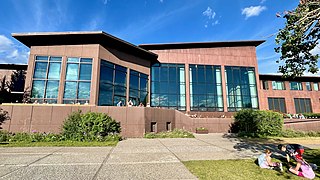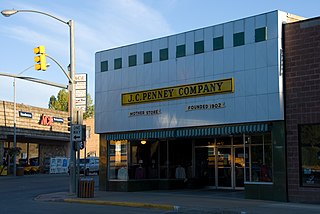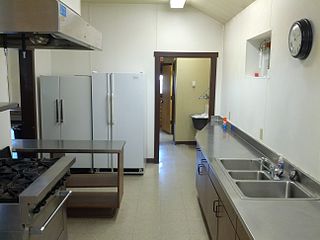
Kemmerer is the largest city in and the county seat of Lincoln County, Wyoming, United States. Its population was 2,415 at the 2020 census.

This is a list of sites in Minnesota which are included in the National Register of Historic Places. There are more than 1,700 properties and historic districts listed on the NRHP; each of Minnesota's 87 counties has at least 2 listings. Twenty-two sites are also National Historic Landmarks.

More than 1,100 properties and districts in Nebraska are on the National Register of Historic Places. Of these, 20 are National Historic Landmarks. There are listings in 90 of the state's 93 counties.

This is intended to be a complete list of the properties and districts on the National Register of Historic Places in Fairfield County, Connecticut, United States. The locations of National Register properties and districts for which the latitude and longitude coordinates are included below may be seen in an online map.

Jackson Lake Lodge is located near Moran in Grand Teton National Park, in the U.S. state of Wyoming. The lodge has 385 rooms, a restaurant, conference rooms, and offers numerous recreational opportunities. The lodge is owned by the National Park Service, and operated under contract by the Grand Teton Lodge Company. The Grand Teton Lodge Company also manages the Jenny Lake Lodge, as well as cabins, restaurants and other services at Colter Bay Village. The lodge is located east of Jackson Lake adjacent to prime moose habitat below the Jackson Lake Dam.

This is a list of the National Register of Historic Places listings in Douglas County, Nebraska.

The J. C. Penney Historic District is a historic district in Kemmerer, Wyoming, encompassing several properties associated with James Cash Penney (1875-1971). The district includes the Golden Rule Store, the first in what became the J. C. Penney department store chain, and Penney's home during the store's early years. The district was declared a National Historic Landmark District in 1978, for Penney's role in creating one of the first national department store chains.
The National Register of Historic Places listings in Syracuse, New York are described below. There are 120 listed properties and districts in the city of Syracuse, including 19 business or public buildings, 13 historic districts, 6 churches, four school or university buildings, three parks, six apartment buildings, and 43 houses. Twenty-nine of the listed houses were designed by architect Ward Wellington Ward; 25 of these were listed as a group in 1996.

Wyoming Mercantile, also known as the Aladdin General Store is a preserved small-town general store in Aladdin, Wyoming. The store, which remains in operation, was built in 1896 by Amos Robinson as Wyoming Mercantile. Robinson died the same year, and the store went to Mahlon S. Kemmerer, who placed his properties, including the Wyoming and Missouri Valley Railroad, under the Wyoming Mercantile umbrella. Railroading continued until 1927. The store has continued, serving as a post office, bar, freight station and gas station.

The J. C. Penney House in Kemmerer, Wyoming, was the home of James Cash Penney, the founder of the J. C. Penney department stores, during the 1904-1909 period that he developed his formula for a successful dry goods store. Penney and wife moved to Kemmerer in 1902 and lived in the garret of a small house. With a child, it was too small, and Penney bought this two-storey house in 1904. It was small, too: about 25 feet (7.6 m) wide and sloping down to the back, going about 30 feet (9.1 m) deep.

Hynds Lodge is a conference and accommodation lodge originally built by Cheyenne, Wyoming businessman Harry P. Hynds and donated to the Boy Scouts of America (BSA) in 1922. It is open from May 1 to October 1 by reservation only. It has accommodations for 30 people, a large kitchen, dining room, living room, covered porch, stone fireplace and chimney, and 9 acres (3.6 ha) of land. The lodge was originally used by Wyoming Boy Scouts as a recreational camp. Later it was used by churches, social groups, and businesses. It was built on land that became part of Curt Gowdy State Park in 1971 and is now operated by the park. The south fork of Crow Creek lies nearby, with a granite outcrop and woodlands of cedar and spruce.
Frederic Hutchinson "Bunk" Porter, Sr., sometimes referred to as Frederick Hutchinson Porter, was an American architect based in Cheyenne, Wyoming. He was active from 1911 to approximately 1965. He designed many of Cheyenne's most important public and commercial buildings and also designed several buildings at the University of Wyoming, including War Memorial Stadium and the Agriculture Building. A number of his works are listed on the U.S. National Register of Historic Places.

The Haddenham Cabin, located in Fossil Butte National Monument near Kemmerer, Wyoming, is a historic cabin that is listed on the National Register of Historic Places (NRHP).
The Johnston Scout Rocks near Kemmerer, Wyoming are a pair of sandstone rocks that have significance from 1850. They are listed on the National Register of Historic Places in the category of "Recreation and Culture" with historic subfunction "Work of art ".
Daniel D. Spani, known as D.D. Spani, was an American architect who practiced in Rock Springs, Wyoming. His work includes Rock Springs Elks' Lodge No. 624, which was listed on the National Register of Historic Places for its unique-in-Wyoming architecture, and other architectural landmarks of the city.

The Hotel Wolf is a hotel and restaurant in Saratoga, Wyoming. The two-story brick building was built at an estimated cost of $6000 in 1893 for Frederick G. Wolf, a German immigrant who had operated liquor stores in Wyoming. It opened for dining with a banquet on New Year's Eve 1893. The hotel opened on January 10, 1894. Two years after Wolf's death in 1910 his widow Christina sold the property to George W. Sisson for $10,000. It continues to operate as a hotel and restaurant.
The CM Ranch and Simpson Lake Cabins are separate components of a single historic district associated with Charles Cornell Moore, a Fremont County, Wyoming dude ranch operator. The CM ranch, named after Moore, operated as a dude ranch from 1920 to 1942 and resumed operating in 1945. The Simpson Lake Cabins were purchased by Moore in 1931 and were operated as a hunting camp, continuing until 1997 when the CM ranch was sold to new owners and the Simpson Lake property was taken over by the U.S. Forest Service.. The sites are separated by 13 miles (21 km).
The Big Horn Hotel, on Main St. in Arminto, Wyoming, was built in 1906. It was listed on the National Register of Historic Places in 1978.













